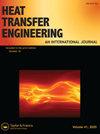Optimization of natural cooled heat sinks for panel mounted solid state relays
IF 1.6
4区 工程技术
Q3 ENGINEERING, MECHANICAL
引用次数: 0
Abstract
ABSTRACTA solid state relay mounted at a cabinet wall dissipating 30W heat is considered in this analysis. A parallel plate mid-finned heat sink is designed for the relay to accommodate within 100 × 60 × 100 mm3 volume. A heatsink of 100 mm × 56 mm base size, 6 mm trunk thickness, 3 mm fin thickness, 6 mm fin spacing, and 102 mm length is attained by optimization. Further, it is optimized by trimming off the inefficient portion of the fin height, thereby attaining a taper heat sink without compromising the thermal performance. The appraisement of this trimming is characterized by the taper angle formed between the base of the heat sink and the line connecting all fin tips. The temperature profiles for heatsinks with 90°, 85° and 80° taper angle are presented in this paper for various power levels. The heat sink with 85° taper angle is optimum and the same is fabricated and tested experimentally. Thus, the parallel plate heat sink is optimized to improve the overall fin effectiveness and a 13% reduction in weight is achieved at 85° taper angle with a notional increment in temperature.DisclaimerAs a service to authors and researchers we are providing this version of an accepted manuscript (AM). Copyediting, typesetting, and review of the resulting proofs will be undertaken on this manuscript before final publication of the Version of Record (VoR). During production and pre-press, errors may be discovered which could affect the content, and all legal disclaimers that apply to the journal relate to these versions also. Additional informationNotes on contributorsPalani Nainar Palani Nainar is orking as a Scientist at SAMEER-Centre for Electromagnetics, Chennai, an R&D institution under the Ministry of Electronics and Information Technology, Govt. of India. He received his Bachelor's Degree in Mechanical Engineering from Madurai Kamaraj University and a Master's Degree from the National Institute of Technology, Trichy. Since 2004, he has established facilities to evaluate, analyze and validate the thermal performance of electronic products in the Electronics Packaging Division at SAMEER.Karuppaiah Ramaiah Karuppaiah Ramaiah is working as a Research Scientist with Electronics Packaging Division in SAMEER-Centre for Electromagnetics, Chennai. He received his Bachelor's Degree in Mechanical Engineering from the University College of Engineering, Anna University, Dindigul. He is working in the area of design and development of thermal management systems for electronics packaging. He has secured knowledge in the use of CAD/CFD tools for thermal analysis of electronic systems.Dhanushkodi Ganesan Dhanushkodi Ganesan received his Bachelor of Engineering from Madurai Kamaraj University in the year 1997 and Master's Degree from Anna University in the year 2007 and joined SAMEER-Centre for Electromagnetics, Chennai. Since 1997 he has been working as a scientist with the Electronics Packaging Division. Currently doing his research in thermal management of electronics systems deployed under harsh environments. Handled several testing and consultancy assignments from commercial electronics to space electronics, module-level to shelter level; established the state-of-the-art test facilities for thermal management of electronics systems.板装固态继电器自然冷却散热器的优化
摘要本文考虑了安装在机柜壁上的固态继电器,其散热功率为30W。为继电器设计了一个平行板中翅片散热器,以容纳100 × 60 × 100 mm3的体积。优化后的散热器底座尺寸为100mm × 56mm,主干厚度为6mm,翅片厚度为3mm,翅片间距为6mm,长度为102mm。此外,它通过修剪掉翅片高度的低效部分进行优化,从而在不影响热性能的情况下获得锥形散热器。这种修剪的评价特点是在散热器的底部和连接所有鳍尖的线之间形成的锥度角。本文给出了不同功率下90°、85°和80°锥角散热器的温度分布。制作了85°锥角的散热片,并对其进行了实验测试。因此,优化了平行板散热器,以提高整体散热效率,并在85°锥度角下实现了13%的重量减轻,同时名义上增加了温度。免责声明作为对作者和研究人员的服务,我们提供了这个版本的已接受的手稿(AM)。在最终出版版本记录(VoR)之前,将对该手稿进行编辑、排版和审查。在制作和印前,可能会发现可能影响内容的错误,所有适用于期刊的法律免责声明也与这些版本有关。Palani Nainar是印度电子和信息技术部下属的研发机构——印度金奈sameer电磁学中心的科学家。他持有Madurai Kamaraj University的机械工程学士学位,以及the National Institute of Technology, Trichy的硕士学位。自2004年以来,他在SAMEER的电子封装部门建立了评估、分析和验证电子产品热性能的设施。Karuppaiah Ramaiah是金奈sameer电磁学中心电子封装部门的研究科学家。他持有the University College of Engineering, Anna University, Dindigul的机械工程学士学位。他在电子封装热管理系统的设计和开发领域工作。他掌握了使用CAD/CFD工具进行电子系统热分析的知识。Dhanushkodi Ganesan于1997年获得Madurai Kamaraj大学的工程学学士学位,并于2007年获得Anna大学的硕士学位,并加入了sameer电磁学中心,金奈。自1997年以来,他一直在电子封装部门担任科学家。目前从事恶劣环境下电子系统热管理的研究。处理多个测试和咨询任务,从商业电子到空间电子,模块级到遮蔽级;建立了最先进的电子系统热管理测试设施。
本文章由计算机程序翻译,如有差异,请以英文原文为准。
求助全文
约1分钟内获得全文
求助全文
来源期刊

Heat Transfer Engineering
工程技术-工程:机械
CiteScore
4.50
自引率
17.40%
发文量
111
审稿时长
7.5 months
期刊介绍:
Publishing 18 issues per year, Heat Transfer Engineering is an unparalleled resource for key advances in the field of heat transfer for the practicing engineer and other workers in the field. The journal publishes analytical, numerical, and experimental articles of lasting interest in the general area of heat-mass transfer and the related fluid mechanics and thermodynamics.
In a clear, easy-to-read format, the journal includes refereed papers of original work, state-of-the-art reviews, articles on new developments in equipment or practices, reviews of fundamentals, heat in history articles, book reviews, news items on people and companies in the field, advertising, and any other items that may be appropriate.
All submitted manuscripts are subject to initial appraisal by the Editor and/or selected members of the Editorial Board, and, if found suitable for further consideration, to peer review by independent, anonymous expert referees.
 求助内容:
求助内容: 应助结果提醒方式:
应助结果提醒方式:


